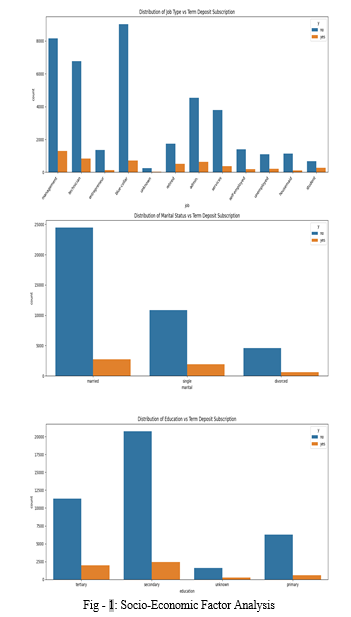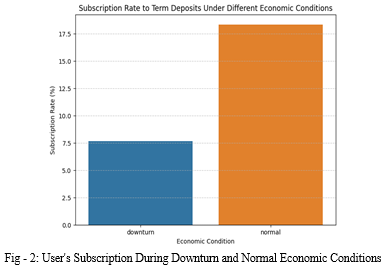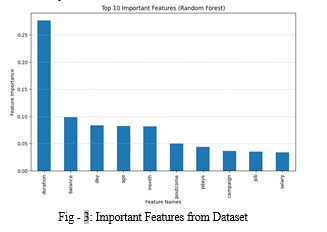Ijraset Journal For Research in Applied Science and Engineering Technology
- Home / Ijraset
- On This Page
- Abstract
- Introduction
- Conclusion
- References
- Copyright
Financial Decision Dynamics: A Machine Learning Exploration into Term Deposit Subscriptions
Authors: Prajwal Deore, Yash Desai, Yashraj Mohite
DOI Link: https://doi.org/10.22214/ijraset.2023.56328
Certificate: View Certificate
Abstract
In today\'s changing economic world, banks are working hard to understand how different groups of people behave financially. They use information like what kind of job a person has, whether they are married, and their level of education to create strategies that encourage people to open term deposit accounts, especially during tough economic times. This study uses a detailed set of data from Kaggle and applies machine learning tools like Random Forest, Logistic Regression, and Decision Trees to understand the complex patterns of how people behave with their money, and what influences their choices, particularly when the economy is down. A new feature called \'economic conditions\' was introduced in this study to better understand how people\'s financial choices change in normal and downturn phases. The standout performer in this study was the Random Forest tool, which showed an accuracy of about 87.8% in predicting if a person would open a term deposit account or not. This study helps banks create strategies that are more in tune with what people want and need, making banking a more personalized and satisfying experience for everyone.
Introduction
I. INTRODUCTION
This document is template. Banks need to understand how different groups of people behave financially, considering their job type, whether they are married, and their level of education, to design the best strategies for encouraging them to open term deposit accounts, especially during tough economic times. Banks can create term deposit offers that are more likely to attract various customers, helping both individuals and banks to stay financially stable even when the economy is not doing well. This approach helps banks keep a strong customer base and remain steady, even in a changing economic landscape.
Socio-economic factors, which encompass elements such as an individual's job type, marital status, and level of education, play a pivotal role in shaping financial behaviours and decisions. These factors, deeply ingrained in the societal fabric, often dictate the financial pathways individuals choose to tread, influencing their risk tolerance, savings propensity, and engagement with various financial products and services, including term deposits. For instance, a person with a higher level of education might exhibit a greater understanding and willingness to engage in investment opportunities compared to someone with a lower education level. Similarly, marital status can influence an individual's financial decisions, with married individuals potentially showcasing different saving and investment patterns compared to their single counterparts. Job type, another significant socio-economic factor, often correlates with financial stability, thereby influencing an individual's financial decisions and behaviours. Thus, a deep understanding of these socio-economic factors not only aids in deciphering the complex web of financial behaviours but also stands central to enhancing customer satisfaction and engagement.
Economic downturns, characterised by a decline in economic activity and reduced consumer spending, invariably influence individual financial behaviours and preferences. During such periods, people tend to become more conservative with their investments, opting for safer and more secure financial products. This research seeks to explore how these economic downturns affect the propensity of individuals to subscribe to term deposits, a traditionally safer investment avenue. Understanding this dynamic can offer pivotal insights into crafting banking strategies that are responsive to economic cycles, thereby helping financial institutions to navigate the complex landscape of fluctuating economic conditions with agility and foresight.
The Bank Marketing dataset from Kaggle consisting of a rich variety of attributes offers a substantial foundation for this research. It encompasses details such as age, job type, marital status, and education, among others, providing a comprehensive view of individual financial behaviours and preferences. This dataset is a key resource for exploring how socio-economic factors affect financial choices, opening up opportunities for new insights in the banking industry.
In this paper, we have used Machine Learning algorithms such as Random Forest, Logistic Regression, and Decision Trees to delve deep into the intricacies of financial behaviours. Furthermore, to refine our analysis and ensure optimal performance, we've implemented feature selection using Random Forest. This approach not only streamlines our dataset but also enhances the accuracy of our scenario analysis, providing a clearer understanding of the financial landscape and the factors that influence it.
II. LITERATURE SURVEY
In recent years, the banking sector has increasingly leveraged data mining and machine learning techniques to enhance the efficacy of telemarketing strategies and understand customer behaviors. Moro et al. (2014) utilized a data mining approach to analyze a wide array of features related to bank clients, products, and socio-economic attributes, highlighting the potential of neural networks in predicting the success of telemarketing campaigns [1]. Similarly, Wang (2020) employed the C5.0 algorithm to classify customers based on the Bank Marketing data from the UCI Machine Learning Repository, emphasizing the necessity of optimal feature selection and dataset balancing to improve predictive accuracy [2]. Oni (2020) also explored the dynamics of bank marketing campaigns, identifying 'duration' as a crucial factor influencing customer subscriptions to term deposits and noting the superior predictive performance of the K-nearest neighbor algorithm [4].
Adding a macroeconomic lens to this discourse, Bluwstein et al. (2023) developed early warning models for financial crisis prediction using machine learning techniques on a substantial dataset encompassing 17 countries over a period of more than a century [10]. The study underscored the significant role of credit growth and the slope of the yield curve in predicting crisis risk, highlighting the nonlinear relationships between these predictors and crisis risk. This body of work collectively illustrates the burgeoning potential of data-driven approaches in banking, showcasing the pivotal role of machine learning and data mining techniques in understanding financial behaviors and predicting market trends with a higher degree of accuracy. It encourages a deeper exploration of the financial markets, integrating macroeconomic perspectives with individual financial behaviors to foster a more robust understanding of the sector.
III. METHODOLOGY
In recent years, The foundation of this research is the Bank Marketing dataset sourced from Kaggle, chosen for its rich array of attributes including age, job type, marital status, and education, which offer a comprehensive view of individual financial behaviours and preferences. To enhance the depth of the research, an attribute termed 'economic conditions' was introduced, bifurcated into 'normal' and 'downturn'. The latter was inferred from individual financial behaviours such as having a loan, housing loan, or defaulting on a loan, while the former was considered as the default state. The target attribute for model construction was "response", delineating whether an individual subscribed to a term deposit, categorised into 'yes' or 'no'.
Before delving into the analytical phase, the dataset underwent a meticulous preprocessing stage where it was scanned for missing values and outliers, followed by the implementation of necessary remedial measures to enhance data quality. Feature engineering techniques were employed extensively, aiding in the extraction of insightful information and facilitating a deeper understanding of the underlying patterns governing financial behaviors. During the model construction with the implementation of the Logistic Regression algorithm, which, despite achieving an accuracy of approximately 87.9%, exhibited a significant bias towards predicting the majority class (class 0 - did not subscribe to term deposit), failing to accurately predict the minority class (class 1 - subscribed to term deposit). This was followed by the application of the Decision Tree Classifier, which demonstrated a better balance in predicting both classes with an accuracy of about 82.6%. However, it was the Random Forest Classifier that stood out, not only improving the precision in predicting the minority class but also achieving an overall accuracy of roughly 87.8%. Despite its superior performance, it exhibited a relatively low recall for the minority class, indicating a presence of false negatives. The detailed performance metrics of each model underscore the nuances of their predictive capabilities, guiding the pathway to further refinements in the analytical strategy to achieve a more balanced and accurate predictive model.
A. Influence of Socio-Economic Factors on Financial Behaviors
Socio-economic factors like job type, education level, and whether someone is married can shape how people handle their money. Banks can use this information to make better plans for term deposit marketing, making sure they match what different groups of people might want or need. This approach leverages insights derived from socio-economic data to create targeted and effective strategies, enhancing the resonance of financial products with diverse customer groups.
- Job Type vs. Term Deposit Subscription: In the dataset, 'blue-collar', 'management', and 'technician' categories encompass the largest demographic groups, illustrating the bulk of the data pool [Fig 1]. In contrast, 'students' and 'retired' individuals, although fewer, demonstrate a stronger inclination to subscribe to term deposits. A detailed examination of the prominent groups reveals a diminished conversion rate, signaling a reduced tendency to opt for term deposits. Conversely, 'students' and 'retired' categories, though smaller, present considerable potential, exhibiting a higher term deposit subscription rate. This scenario underscores a pronounced readiness or predisposition of individuals in these categories to avail themselves of term deposit offers. Considering the pronounced inclination of 'students' and 'retired' individuals to subscribe, financial institutions have the opportunity to craft targeted marketing strategies for these demographics. Developing tailored products that meet the distinct needs and preferences of these groups could amplify subscription rates, fostering more rewarding relationships.

2. Marital Status vs. Term Deposit Subscription: Marital status analysis indicates that married individuals form the majority but are less inclined to subscribe to term deposits compared to single counterparts, highlighting a subdued engagement with term deposit subscriptions [Fig-1]. Married individuals might priorities other financial obligations or find satisfaction with existing financial products, resulting in a decreased subscription rate. In contrast, single individuals display a heightened engagement level, possibly characterized by a higher risk tolerance or a proactive approach to financial planning. Financial institutions could consider introducing products crafted exclusively for married individuals to encourage deeper engagement. Furthermore, initiating financial literacy programs for single individuals could foster a broader understanding of the advantages of term deposits, guiding informed financial decisions.
3. Education vs. Term Deposit Subscription: An educational background overview reveals that while individuals with secondary education predominate, they do not exhibit the highest term deposit subscription rate [Fig-1]. A slightly elevated tendency to choose term deposits is observed among individuals with tertiary education, suggesting a linkage between advanced education and financial decision-making. Despite forming a significant part of the customer base, individuals with secondary education do not register the highest subscription rate. In contrast, individuals with tertiary education, likely more adept at financial matters, exhibit a preference for term deposits, leveraging the perks of savings and investments. Financial institutions could priorities educational initiatives targeting the large demographic with secondary education to foster understanding and interest in term deposits. For the group with tertiary education, offering sophisticated financial products could encourage deeper financial engagement, potentially leading to a surge in subscription rates while nurturing a financially astute customer base.
B. Impact of Economic Downturn on Financial Behaviors
Economic downturns, discernible through individual financial behaviors and preferences, significantly influence the propensity to subscribe to term deposits. Individuals tend to gravitate towards more secure investment avenues, such as term deposits, to safeguard their finances during unstable economic phases. Analyzing these behaviors provides a lens to understand the shifts in financial preferences and the corresponding impact on term deposit subscriptions during economic downturns. This analysis is pivotal in tailoring banking strategies that are responsive to varying economic conditions.

In the analysis of the economic downturn and normal conditions, there was a discernible difference in the behavior of individuals towards subscribing to term deposits. During normal economic conditions, a substantial 18.36% of individuals chose to subscribe, showcasing a tendency to opt for savings instruments in stable economic phases. Contrastingly, the economic downturn saw a significant dip in subscriptions, plummeting to a mere 7.69%. This stark contrast underscores a heightened sense of financial caution prevalent among individuals in adverse economic environments. Banks, therefore, face the imperative task of adapting their strategies to maintain a steady influx of subscriptions, leveraging insights from changing financial behaviours across varying economic landscapes.
Further, In the study conducted to assess how varying economic conditions affect the propensity of individuals to subscribe to a term deposit, three distinct scenarios were examined. In the baseline scenario, wherein all features were calibrated to their mean values, there was a predicted subscription likelihood of 43%. An economic downturn scenario was simulated by augmenting the "day" feature by one standard deviation and diminishing the "balance" feature by the same measure, resulting in a 40% subscription likelihood. Surprisingly, in the economic uptrend scenario characterized by a decrement in the "day" feature and an increment in the "balance" feature by one standard deviation, the subscription likelihood experienced a slight dip to 39%. This analysis elucidates that an economic uptrend does not invariably engender an increased willingness to subscribe to term deposits, indicating a nuanced landscape of financial behavior in fluctuating economic environments.
IV. RESULTS
In recent years, the research paper highlights the superior performance of the Random Forest Classifier in predicting term deposit subscriptions with an accuracy of about 87.8%. Despite its effectiveness, it showed room for improvement in reducing false negatives, as indicated by a lower recall rate for the minority class.

The research further highlighted the key elements that affect people's choices about term deposit subscriptions, the Random Forest technique was used. This method is great at sorting through detailed data to point out the most important aspects. Foremost is the "duration" feature, denoting the last contact duration, which unsurprisingly emerges as the most significant factor; a longer duration could imply a more comprehensive discussion, thereby potentially facilitating a deeper understanding and fostering a greater inclination towards subscription. Following closely are attributes such as "balance," representing an individual's economic stability, and "day" and "month," which might be reflective of the cyclical financial behaviors and preferences — a nuanced understanding of which can provide banks with the opportune moments to approach potential clients. The "age" feature similarly holds importance, perhaps delineating the varying financial prudence’s and risk appetites that naturally segregate different age groups. Leveraging these pivotal features can thus empower financial institutions with enriched insights, driving informed strategies to enhance term deposit subscriptions in varying economic climates.
Based on our detailed analysis, the following strategies emerge as potent avenues for banks to enhance their term deposit subscription rates:
- Focus on Specific Demographics: Direct marketing efforts towards students and retired individuals, as they are more likely to subscribe to term deposits.
- Create Tailored Offers: Develop special offers for single individuals and those with tertiary education to encourage them to subscribe to term deposits.
- Understand Economic Influences: Banks should analyze how different economic conditions affect client behaviors and preferences, and use this understanding to create strategies that align with current economic trends.
- Strategize Communication Timing: Utilize data on the most effective days to contact clients, aiming to choose the most opportune times to communicate and thereby increase subscription rates.
Conclusion
A deep exploration of the relationship between socio-economic factors and their influence on financial decisions, with a focus on term deposit subscriptions, was undertaken. Utilizing a comprehensive dataset from Kaggle, the study shed light on the nuanced ways individual financial behaviors and preferences shift in varying economic conditions. The addition of an \'economic conditions\' attribute to the dataset facilitated a more detailed analysis, helping to distinguish financial behaviors in normal and downturn economic phases. This initiative underscored the critical role of understanding economic trends in predicting term deposit subscriptions, highlighting that economic uptrends do not necessarily lead to higher subscription rates. The research employed machine learning algorithms such as Logistic Regression, Decision Tree, and Random Forest to analyses the dataset, unveiling patterns and trends pivotal in understanding financial behaviors across different socio-economic groups. Despite encountering challenges due to imbalanced data, the study demonstrated the potential of these algorithms in extracting meaningful insights. Moreover, the research offers banks a blueprint for more personalized and effective banking strategies, emphasizing targeted marketing, tailored offers, and strategic communication timing. These strategies, grounded in a deep understanding of individual preferences and needs, pave the way for a banking ecosystem that is both responsive and aligned with the diverse needs and aspirations of its clientele, steering towards a future of inclusivity and heightened customer satisfaction.
References
[1] S. Moro, P. Cortez, and P. Rita, “A data-driven approach to predict the success of bank telemarketing,” Decision Support Systems, vol. 62, pp. 22–31, Jun. 2014, doi: 10.1016/j.dss.2014.03.001. [2] D. Wang, “Research on Bank Marketing Behavior Based on Machine Learning,” International Conference on Artificial Intelligence and Advanced Manufacture (AIAM2020), Oct. 2020, doi: 10.1145/3421766.3421800. [3] P. ?ady?y?ski, K. ?bikowski, and P. Gawrysiak, “Direct marketing campaigns in retail banking with the use of deep learning and random forests,” Expert Systems With Applications, vol. 134, pp. 28–35, Nov. 2019, doi: 10.1016/j.eswa.2019.05.020. [4] J. Olalekan Oni, “Exploratory analysis of bank marketing campaign using machine learning; logistic regression, support vector machine and knearest neighbour.,” School of Computing National College of Ireland, Aug. 2020. [5] Wenxi Zhang, “Application of machine learning algorithm in bank telephone marketing,” 3rd International Conference on Computer Science and Intelligent Communication (CSIC 2022), 2022. [6] T. Renault, “Sentiment analysis and machine learning in finance: a comparison of methods and models on one million messages,” Digital Finance, vol. 2, no. 1–2, pp. 1–13, Sep. 2019, doi: 10.1007/s42521-019-00014-x. [7] T. Warin and A. Stojkov, “Machine Learning in Finance: A Metadata-Based Systematic Review of the Literature,” Journal of Risk and Financial Management, vol. 14, no. 7, p. 302, Jul. 2021, doi: 10.3390/jrfm14070302. [8] [8] H. Altinbas, “The influence of the pandemic on financial decisions made by individuals in Turkey: A cross-sectional study,” Decision, vol. 49, no. 3, pp. 341–353, Sep. 2022, doi: 10.1007/s40622-022-00328-7. [9] [9] A. Mirestean et al., “Powering the Digital Economy: Opportunities and risks of Artificial intelligence in finance,” Departmental Paper, vol. 2021, no. 024, p. 1, Oct. 2021, doi: 10.5089/9781589063952.087. [10] [10] Bluwstein, Kristina, et al. \"Credit growth, the yield curve and financial crisis prediction: Evidence from a machine learning approach.\" Journal of International Economics (2023): 103773.
Copyright
Copyright © 2023 Prajwal Deore, Yash Desai, Yashraj Mohite. This is an open access article distributed under the Creative Commons Attribution License, which permits unrestricted use, distribution, and reproduction in any medium, provided the original work is properly cited.

Download Paper
Paper Id : IJRASET56328
Publish Date : 2023-10-27
ISSN : 2321-9653
Publisher Name : IJRASET
DOI Link : Click Here
 Submit Paper Online
Submit Paper Online

